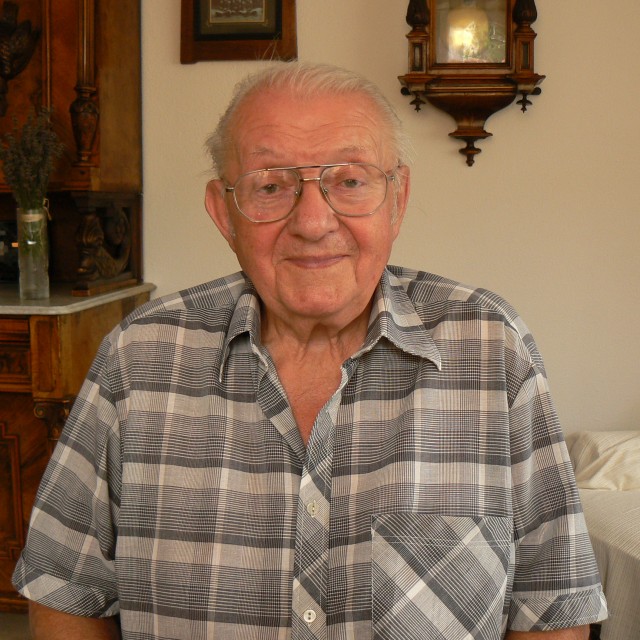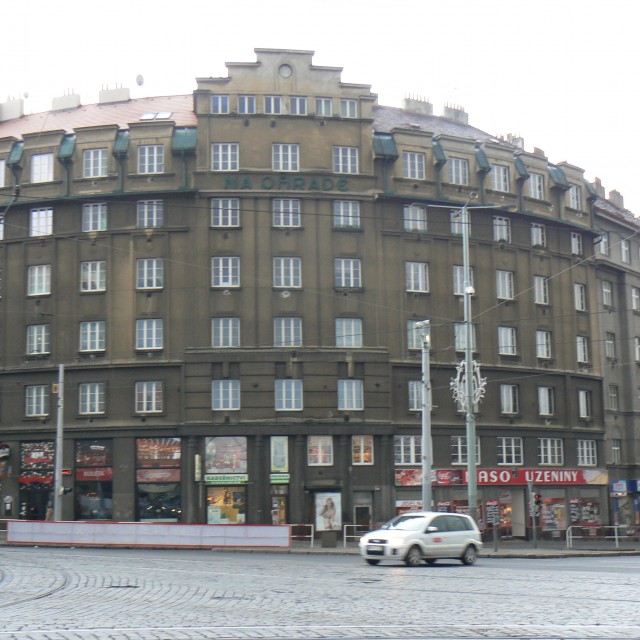The Commander Is Dead
Jaroslav Staněk, member of the Scout troop no. 52 that continued to operate even during World War II. in spite of being prohibited by the Nazis, participated in the Prague Uprising in Žižkov. One of the important missions was the seizure of the agricultural settlement Pražačka, which used to be the SA headquarters during the war. “In the early morning of May 6, 1945, we set out under the leadership of our commander Jaroslav Bočinský towards the end of Želivského Street (the then Mladoňovičova Street) with the intention to seize the agricultural settlement Pražačka. Pražačka was located in what is now Koněvova Street, right across the round apartment building which is at the left end of Želivského Street. We lied down behind a low barricade made out of cobblestones that was located at the end of Želivského Street, where the zebra crossing is nowadays. It was one of the many barricades people were constructing in the streets after they had heard the calls on the radio. Suddenly, we heard shooting from Pražačka. Jaroslav Bočinský, who was armed with a light machine gun 26, told us that the Germans have large-caliber four barrel machine gun hidden in the settlement and that he would get to the top of the round house. He planned to kill the Germans from there and cover our attack, once we start shooting and throwing hand grenades. So we waited for Bočinský to start shooting. When he started, the German four barrel machine gun with armoured shield started to fire back and Bočinský’s weapon went silent. We stayed hidden behind the barricade, ready to attack. Then one of us got up to find out what happened to Bočinský and he came back with terrible news – Bočinský was dead, the German shot pierced his chest.”
Hodnocení
Abyste mohli hodnotit musíte se přihlásit!
Trasy
Příběh není součastí žádné trasy.
Komentáře

Jaroslav Staněk
Jaroslav Staněk was born on February 16, 1926, in Nová Cerekev in the region of Vysočina. However, soon after his birth the family moved to the city district of Žižkov in Prague, where his father worked as a tram driver. Jaroslav Staněk attended an elementary school (The First Boy School on Comenius Square) and also joined the Scout. He then attended a grammar school in Dvořákova Street. In 1942, he began his studies at the engineering college in Betlémská Street. Before he took up his studies at the engineering college, he had to complete an apprenticeship at the Kolben factory in Vysočany. In 1940, Jaroslav and other boys from Žižkov founded a scout troop. The Scout main office registered them as the number 52. František Nový became the leader of the troop. However, shortly afterwards, the Nazis made the Scout illegal and its activities had to be carried out secretly. During the Prague uprising, Jaroslav Staněk fought at the barricades in Žižkov as well as in the Prague city center. On May the 5th, they were issued orders in the main office of the organization "Movement for Freedom" (Hnutí za svobodu) in Kollárova Street and were handed out firearms in the house „U Bulhara". Their first task was to occupy the printing office of the National Bank near Jindřišská věž, the second task was to occupy the editorial office of the German newspaper "Der Neue Tag" in Panská Street. Jaroslav Staněk also took part in the seizure of the agricultural settlement Pražačka. Two of his Scout friends - Jaroslav Bočínský and Vladimír Hauff – died during the fighting on the barricades. After the war, Jaroslav Staněk joined the Communist party by the end of February 1946. After his graduation from an engineering college, he got a job in the Křižík factory in Vysočany where he was assembling gas meters. In February 1948, he organized and took part in the nation-wide general strike. In October, he enrolled in the military center in Pilsen as a private. His training was completed in June 1949 and he was transferred to a course in public-awareness raising for reserve officers that took part in Litoměřice. From here, he was later transferred to the main administration in Prague. Then he spent some time in the Slovak town of Martin, where he served in the political department of the armaments training center. Later, acting on the orders of Colonel Bedřich Kopold, he took up service in the political department of the Military Institute in Prague. After just a couple of months, he was delegated to the Military-engineering academy in Smíchov, where he served in the position of a so-called educational superintendent. He didn't escape the purges in the Communist apparatus. Two events adversely affected his further fate: the escape abroad of one officer who was transferred to the border guard and the arrest of Colonel Bedřich Kopold. Jaroslav Staněk was accused of being a saboteur and he was deprived of his status of a political officer. In April 1951, he was assigned as a desk officer to the Ministry of National Defense responsible for the area of defense planning. Later, he was transferred to the military department of the Office of the presidium of the government. In 1959, he began to work at the chiefs of staff, responsible for the analysis of information on the French armaments industry. In 1960, he completed his studies at the engineering faculty in Prague. Later, he again worked for the government. After the events of 1968, he was dismissed and took up a position in the Research Institute for mathematical machines. He retired in 1990.



